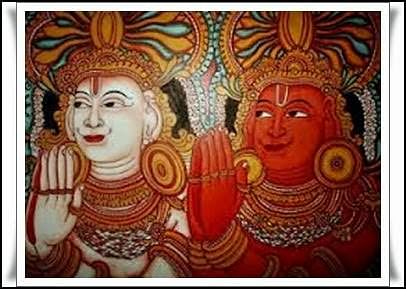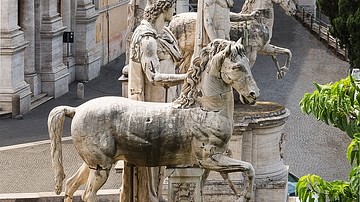
The Ashvins (aka Asvins, Asvinau, or Asvini Kumaras) are two twin brothers of Hindu mythology, sons of the sun god Surya. They may also be referred to as the 'Horsemen' and are forever young, handsome, and athletic. They are considered the physicians of the gods. As twins, they represent a cosmic duality of ideas such as light and dark, healing and destruction. In many ways they are similar to the Dioskouroi (Castor and Pollux) of Greek and Roman mythology and may well have been based on historical figures, perhaps two rulers famous for their skills in battle and good deeds.
Surya & Samjna
The Ashvins appear in Vedic literature (1500 – 1000 BCE) as the twin sons of Surya the sun god or of the sky. Their mother is Samjna (Conscience), the daughter of Visvakarma. Unfortunately, Samjna became so tired of Surya's brilliant light that she one day gave him a handmaid, Chaya (Shade), and left him to live a life of reflection in the forests, transformed into a mare. Surya was not to be so easily deprived though and disguised as a stallion mated with Samjna. The resulting offspring were Revanta (chief of the Guhyakas) and the two twins. The twins are also considered the parents of Nakula and Sahadeva, the Pandu princes.
Associations
The two brothers are forever youthful, handsome, brilliant, golden, fast, and athletic. Compassionate, they help those in need from old women to soldiers left behind by a retreating army. They also represent duality, can change their form at will, and possess the power to cure. Indeed, this latter ability meant that they are the subject of many Hindu hymns as they are considered the official doctors of svarga, one of the intermediary heavens and realm of Indra. In this guise, they are known individually as Dasra and Nasatya or collectively as Dasras, Nasatyas, Gadagadau, or Svarvaidyau.
The Ashvins' name derives from the Sanskrit asva or 'horse' and they are closely associated with that animal, sometimes even considered to have the bodies of men and the head of a horse, but as with many other Hindu deities, they have several alternative names too. These include Abdhijau ('ocean born'), Badaveyau (after their father in some texts, Badava, underground fire), and Puskarasrajau ('wreathed in lotuses'). The Ashvins are very rarely depicted in ancient Hindu art, but they do appear as figure sculptures on the 12th-century CE gopurams (monumental gates) at Chidambaram.
Ashvins & Cyavana
The Ashvins' medical skills famously helped the sage Cyavana who, when he reached a very old age, they returned to a state of youth. This apparently selfless act was in fact motivated by a promise from Cyavana's wife Sukanya that should they restore good health to her husband then she would reveal to the Ashvins the one thing which they lacked to become complete gods. The twins obliged and told Cyavana to bathe in a pond, and on immersing himself in its waters, he emerged as a sprightly youth. Good on her promise, Sukanya then told the Ashvins that they were not complete because they did not drink the elixir soma, like the other gods.
The twins then set about acquiring some soma and eventually succeeded in persuading Dadhyanc, son of the Atharvan priest, to teach them the sacrificial ceremony which involved the sacred drink. There had been the problem that Indra did not want the Ashvins to drink soma as they were, he felt, contaminated by their spending too much time with humans. The great god threatened terrible revenge if the twins were to find out about the ceremony and get their hands on soma. The Ashvins got around this by giving Dadhyanc a new head so that when Indra did find out he had taught them of soma, he lopped off Dadhyanc's new head but then, having carefully stored it, the Ashvin's were able to give back to Dadhyanc his original head.
Bringers of the Sun
The Ashvins have another important duty, which is to ride with their father in his golden chariot across the sky each day as he brings warmth and sunlight to the earth. Sometimes they have their own golden chariot which has three wheels and is pulled by either horses or birds, on other occasions they ride only their horses. Specifically, they precede their father and so have become the personification of the morning twilight. As they strike their horses with their whips, they dispel the morning dew.






